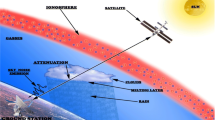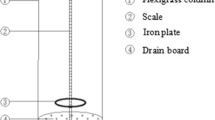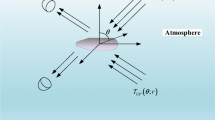Abstract
In view of wide application areas of the millimeterwave frequency band (18–300 GHz) in recent years for various civil and defence applications including radar and communications, remote sensing and radio astronomy, we were prompted to undertake a theoretical estimate of the variation of specific attenuation (dB/Km) with radio meteorological parameters in clear weather conditions. The results of the estimation of the attenuation in this frequency band for some major locations in India from available radio meteorological data from NOAA, USA are presented in this paper. An appreciable amount of shift, which is mainly a function of the atmospheric pressure, temperature and relative humidity was noticeable in each of the window frequencies around 35, 94, 140 GHz and 220 GHz.
Similar content being viewed by others
Reference
Allen, K. L., H. J. Liebe and C. M. Rush, (1983) “Estimates of Millimeter Wave Attenuation for 18 United States cities”, NTIA Rep., pp. 83–119, Natl. Telecommunication and Information Admin, Boulder., Colorado.
Altshuler, E.E., R.A. Marr, “A comparison of experimental and theoretical values of atmospheric absorption at the longer millimeter wavelengths”, IEEE Trans on Ant. & Prop., Vol. 36, No. 10, pp. 1471–1480.
Carter, C. J., R. L. Mitchell, and E. E. Reber (1968), “Oxygen Absorption Measurements in the lower atmosphere”, J. Geophys. Res., 73, pp. 3113–3120.
Crane, R. K., (1980), “Attenuation estimates for the millimeter wave windows near 94, 140, 220 GHz,” ERT Doc. P A502, Environ. Res. Technol. inc., Concord, MA.
Gaut, N. E., and E. C. Reifenstein III (1971), Environ. Res. Technol. Inc. Rep. No. 13, Lexington, MA.
Gibbins, C. J. (1986), “Improved Algorithms for the Determination of Specific Attenuation at Sea Level by Dry Air and Water Vapour, in the Frequency Range 1 350 GHz.”, Radio Sci., 21, 949–954.
Gross, E. P., (1955), “Shape of Collision Broadened Spectral lines”, Phys. Rev., 97, pp. 395–403.
Liebe, H. J. (1969), “Calculated Tropospheric Dispersion and Absorption Due to the 22 GHz Water Vapor Line”, IEEE Trans. Ant. Prop., AP 17, pp. 621–627.
Liebe, H. J. (1981), “Modeling Attenuation and Phase of Radio waves in Air at Frequencies Below 1000 GHz.”, Radio Sci., 16, pp. 1183–1199.
Liebe, H. J. (1983), “Atmospheric EHF Window Transparencies near 35, 90, 140 and 220 GHz”, IEEE Trans. Ant. Prop., AP 31, pp. 127–135.
Liebe, H. J. (1985), “An Updated Model for Millimeter Wave Propagation in Moist Air”, Radio Sci., 20, pp. 1069–1189.
Liebe, H. J. (1989), “MPM... An Atmospheric Millimeter Wave Propagation Model”, Int. J. of Infra. & Millimeter Waves, 10, pp, 631–650.
Liebe, H. J., T. Manabe, G. A. Hufford, (1989), “Millimeter wave Attenuation and Delay Rates Due to Fog/Cloud conditions”, IEEE Trans. Ant. Prop., AP 37, pp. 1617–1623.
Meeks, M. L., and A. E. Lilley (1963), “The Microwave Spectrum of Oxygen in the Earth's Atmosphere”, J. Geophys. Res., 68, pp. 1683–1703.
Rosenkranz, P.W. (1975), “Shape of the 5 mm Oxygen band in the Atmosphere”, IEEE Trans. Ant. Prop., AP 23, pp. 498–506.
Smith, E.K. (1982), “Centimeter and Millimeter wave Attenuation and Brightness Temperature Due to Atmospheric Oxygen and Water Vapor”, Radio Sci., 17, pp. 1455–1464.
Tolbert, D.E., and A. W. Straiton (1963), “Synopsis of attenuation and Emission Investigation of 58 to 62 kMc. frequencies in the Earths Atmosphere”, Proc. IEEE, 51, pp. 1754–1760.
Ulaby, F.T., R. K. Moore and A. K. Fung, (1981), Microwave Remote Sensing Active and Passive, Vol. 1, Addison Wesley Pub. Co.
Van Vleck, S.H. and V. F. Weisskopf (1945), “On the shape of Collision Broadened lines”, Rev. Mod. Phys., 17. pp 227–236.
Waters, J. W. (1976), “Absorption and Emission of Microwave Radiation by Atmospheric Gases in Methods of Experimental Physics”, M. L. Meeks ed., 12, Part B, Radio Astronomy, Academic Press, Section 2.3.
Zhevakin, S. A., and A. P. Naumov, (1965), “The Coefficient of Absorption of Centimeter and Millimeter Radio waves in Atmospheric Oxygen”, Radio Eng. Election. Phys (USSR), 10, pp. 844–852.
Author information
Authors and Affiliations
Rights and permissions
About this article
Cite this article
Sen, A.K., Mitra, A., Datta, S.K. et al. Shift of millimeterwave window frequencies in relation to tropospheric radio meteorological parameters. Int J Infrared Milli Waves 13, 1183–1203 (1992). https://doi.org/10.1007/BF01009060
Received:
Issue Date:
DOI: https://doi.org/10.1007/BF01009060




